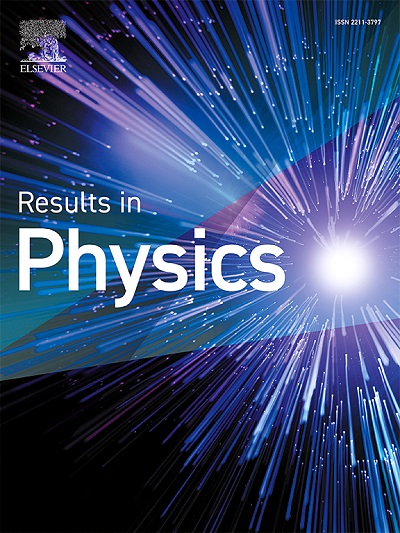Thermal performance analysis of quaternary hybrid nanofluids with radiative and Joule heating effects in magnetohydrodynamic flow over a stretched surface
IF 4.4
2区 物理与天体物理
Q2 MATERIALS SCIENCE, MULTIDISCIPLINARY
引用次数: 0
Abstract
In this study, the thermal behavior of hybrid nanofluids (HNFs) composed of aluminum (), titanium (), copper (), and silver () nanoparticles dispersed in water. Hybrid nanofluids are considered for two-dimensional unsteady flow over porous stretched sheets under the influence of an inclined magnetic field and a non-uniform heat source/sink. The governing partial differential equations (PDEs) are transformed into a set of ordinary differential equations (ODEs), using appropriate transformation. These ODEs are then solved numerically to obtain the desired results. The solution procedure is carried out using numerical simulations, specifically the shooting method and the 4th-order Runge-Kutta (Rk-4) technique. The results are graphically presented to demonstrate the effect of various parameters on heat transfer and velocity profiles. A key objective of this study is to contrast the numerical results with previous results in the literature. The analysis shows that changes in the inclination angle of the magnetic field lead to a decrease in the velocity profile. Moreover, the presence of a heat source significantly enhances the temperature of the nanofluid (NF), with variations in wall shear stress, the Nusselt number, and heat transfer rate reveal important physical insights into the system’s behavior. This investigation supports to a deeper understanding of the thermodynamics of hybrid nanofluids, offering potential for optimization in thermal management and other engineering applications.
具有辐射和焦耳热效应的四元杂化纳米流体在拉伸表面磁流体动力流动中的热性能分析
在这项研究中,混合纳米流体(HNFs)组成的铝(Al2O3),钛(TiO2),铜(Cu),银(Ag)纳米颗粒分散在水中的热行为。考虑了在倾斜磁场和非均匀热源/热源影响下多孔拉伸片上的二维非定常流动混合纳米流体。通过适当的变换,将控制偏微分方程转化为一组常微分方程。然后对这些ode进行数值求解以获得期望的结果。求解过程采用数值模拟,具体采用射击法和四阶龙格-库塔(Rk-4)法。结果以图形形式展示了不同参数对传热和速度分布的影响。本研究的一个关键目标是将数值结果与文献中先前的结果进行对比。分析表明,磁场倾角的变化会导致速度剖面的减小。此外,热源的存在显著提高了纳米流体(NF)的温度,其壁面剪切应力、努塞尔数和传热率的变化揭示了对系统行为的重要物理见解。这项研究有助于更深入地了解混合纳米流体的热力学,为热管理和其他工程应用的优化提供了潜力。
本文章由计算机程序翻译,如有差异,请以英文原文为准。
求助全文
约1分钟内获得全文
求助全文
来源期刊

Results in Physics
MATERIALS SCIENCE, MULTIDISCIPLINARYPHYSIC-PHYSICS, MULTIDISCIPLINARY
CiteScore
8.70
自引率
9.40%
发文量
754
审稿时长
50 days
期刊介绍:
Results in Physics is an open access journal offering authors the opportunity to publish in all fundamental and interdisciplinary areas of physics, materials science, and applied physics. Papers of a theoretical, computational, and experimental nature are all welcome. Results in Physics accepts papers that are scientifically sound, technically correct and provide valuable new knowledge to the physics community. Topics such as three-dimensional flow and magnetohydrodynamics are not within the scope of Results in Physics.
Results in Physics welcomes three types of papers:
1. Full research papers
2. Microarticles: very short papers, no longer than two pages. They may consist of a single, but well-described piece of information, such as:
- Data and/or a plot plus a description
- Description of a new method or instrumentation
- Negative results
- Concept or design study
3. Letters to the Editor: Letters discussing a recent article published in Results in Physics are welcome. These are objective, constructive, or educational critiques of papers published in Results in Physics. Accepted letters will be sent to the author of the original paper for a response. Each letter and response is published together. Letters should be received within 8 weeks of the article''s publication. They should not exceed 750 words of text and 10 references.
 求助内容:
求助内容: 应助结果提醒方式:
应助结果提醒方式:


